
Hope for a huge, ancient and imperilled fish
First Nations are leading efforts to make sure lake sturgeon can find a home in...
The air is biting cold as Willie Bertacco navigates his motorboat through the blackness that obscures where sky and water meet. Bertacco, a skilled hunter from Lake Babine Nation, is up looking for moose before dawn. Babine Lake, part of his nation’s territory in what’s now known as northern British Columbia, is turbulent this morning, and the boat smashes against each wave.
Mateen Hessami, an ecologist and hunter, is out with Bertacco. “It’s easy to tell it’s moose and elk season when Willie is going as fast as he can against the wind,” Hessami jokes.
It’s the end of September, just before rutting season picks up in October. This is among the best times of year to hunt bull moose, Hessami explains, before the surging testosterone and fasting that accompanies rutting season makes the animals’ meat gamey. One bull moose will yield about 350 to 550 pounds of meat, Bertacco says — enough to feed his family through winter and share with the community.
“The only meat we buy at the store is chicken,” Bertacco says. Elk, deer and moose fill his freezer. He was always drawn to hunting, and felled his first moose at 12 years old.
“Growing up, there has always been a hunter in the family,” he says. “There’s nothing better than harvesting an animal you have hunted.”
But Bertacco, now in his mid-30s, has witnessed worrying changes since his first boyhood hunt. Moose in the territory have declined since the early 2000s — by 33 per cent in the Burns Lake area, and by between 50 and 70 per cent in Interior B.C., according to some estimates.
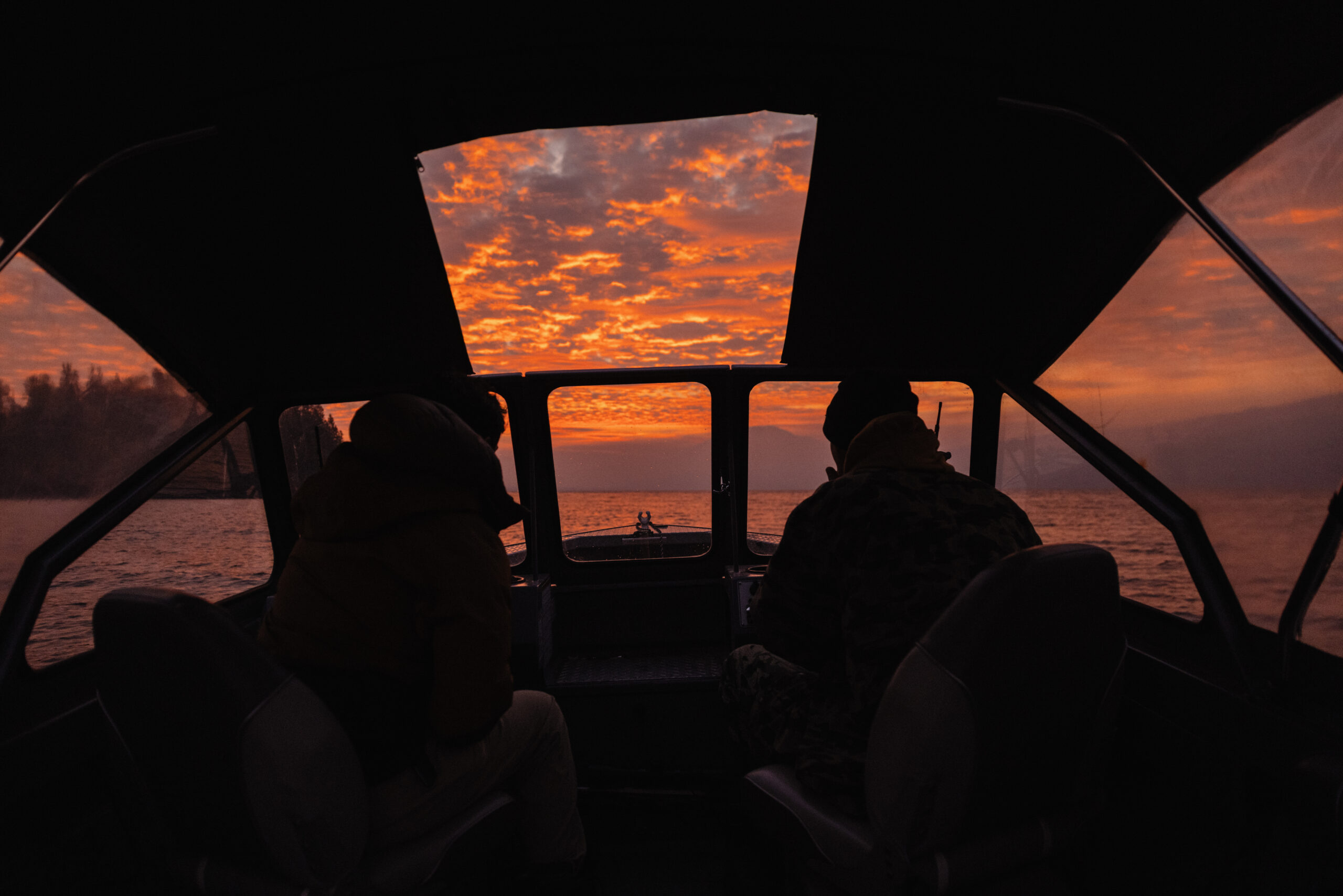
In other parts of the province, moose populations are thriving, and provincially, the species is not considered threatened or endangered. But that’s no consolation to the First Nations whose food source is disappearing from their homelands, and their experience highlights the need for nation-specific approaches to ecosystem management. That’s why Lake Babine has been collaborating with the provincial government to develop a moose enhancement plan since 2022. The plan is rooted in Lake Babine’s governance and practices and the condition of their homelands, and grounded in the inherent right of First Nations hunters like Bertacco to harvest their traditional foods.
The draft plan grapples with technical questions about how to increase moose populations in a drastically changed physical, social and legal landscape. It also brings up more thorny questions about what wildlife people value, what kinds of harvesting the wider public buys into and how to overcome jurisdictional obstacles between B.C. legislation and Indigenous sovereignty.
On the lake, the September sky glows softly at first, and then erupts with a sunrise that burns pink and gold. The morning light illuminates a thick coat of smoke over one side of the lake, lingering from B.C.’s most destructive wildfire season in history.
Suddenly, Bertacco cuts the engine and we fall quiet. There’s a moose on a pebbly beach, calmly looking out at the water. It’s a perfect opportunity — but it’s a cow, and to preserve moose populations, Bertacco and many other hunters will not hunt cows or calves.
“It comes down to respect for the animals,” he says.
Bertacco makes some moose calls, and the cow responds. He hopes to lure out a bull he’s sure must be nearby — where there’s a cow, usually a bull isn’t far, he says.
The cow calls back, but then she disappears into the woods. No bull emerges. Bertacco keeps moving.
Moose hunting has been restricted in the area for non-Indigenous hunters. Bertacco wants to see the restrictions stay in place, since moose face many challenges to recovering their populations.
“Open season for moose is bad,” he says. “Everybody out here, hundreds of people, and they can shoot any bull moose … and then you got the predators out here, a lot of wolves.”
Shortly after seeing the cow moose, Bertacco spots a bull elk on the beach and cuts the engine again. He calls to the elk, and the animal is enraptured. He gets into the water and starts swimming towards the boat, looking for the cow elk he believes he’s hearing, before returning to the beach and staring at us curiously. Bertacco takes his time setting his scope. The boat rocks on the waves. Bertacco tilts with the boat as he focuses on the moving bull. We’re all silent, until his shot rings through the quiet morning and hits the elk in the shoulder.
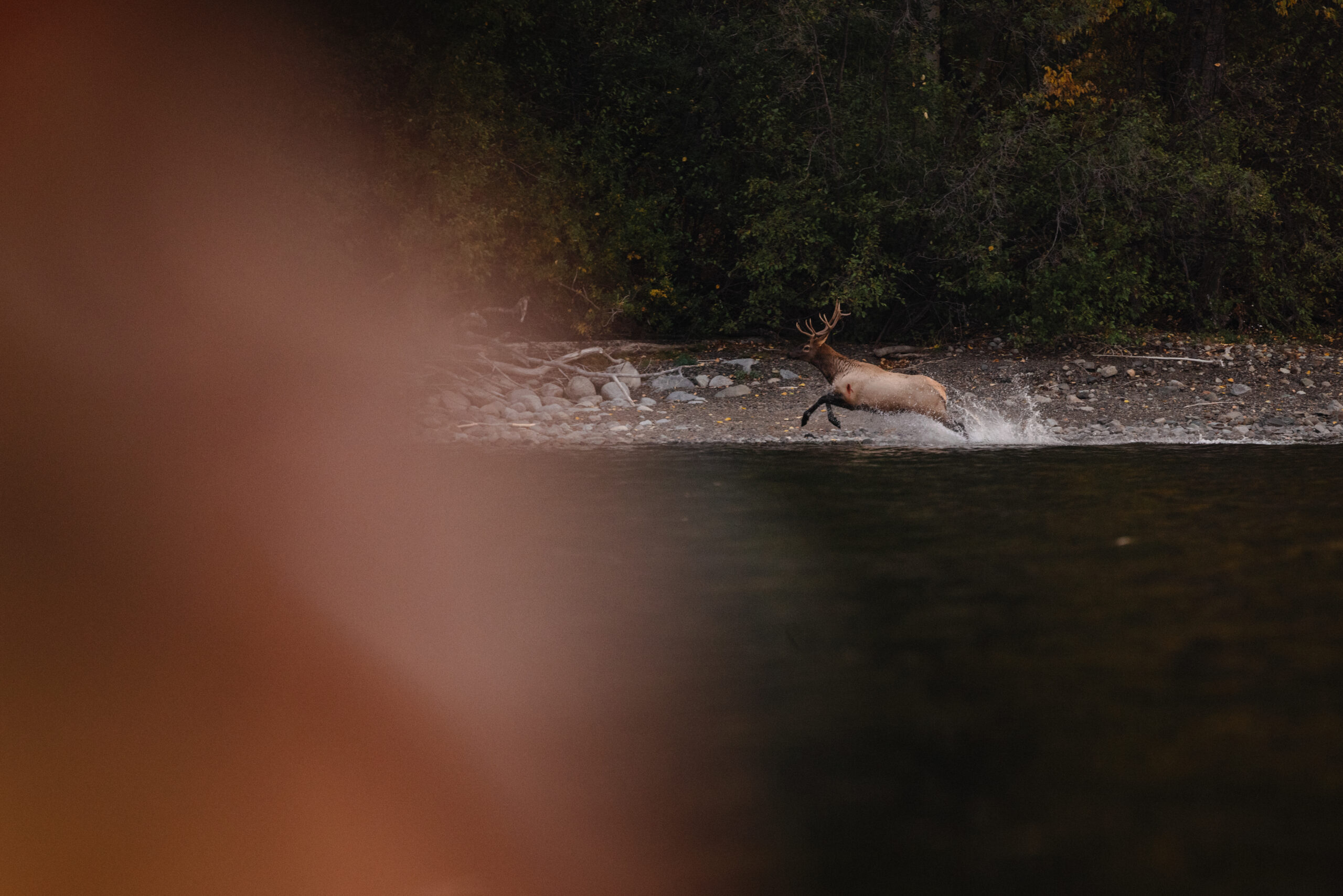
The wounded elk retreats into the woods, not far from the shoreline. After beaching the boat, Bertacco and Hessami listen for the bull and wait for him to pass on in peace before we approach.
They lay tobacco in thanks and begin to harvest. Bertacco’s voice stays low and soft as he describes what he’s doing — trying to avoid cutting the bladder, trying to keep the hide intact. Steam from the elk’s body plumes into the cold air. After gutting the elk, they pull it from the trees onto the beach to finish skinning and processing the carcass. The sun is up, warming the rocks where they work.
“It was a little challenging at first, it was rocking quite a bit, but I got a bit of a calm spot there,” Bertacco says of his shot, which he took from about 180 metres away.
“It was a hell of a shot,” Hessami replies. “You really made that look easy. Most people would not be able to shoot that.”
Overhead, crows begin cawing.
“The crows know,” Bertacco says. “The dinner bell sounded when the gun went off.”
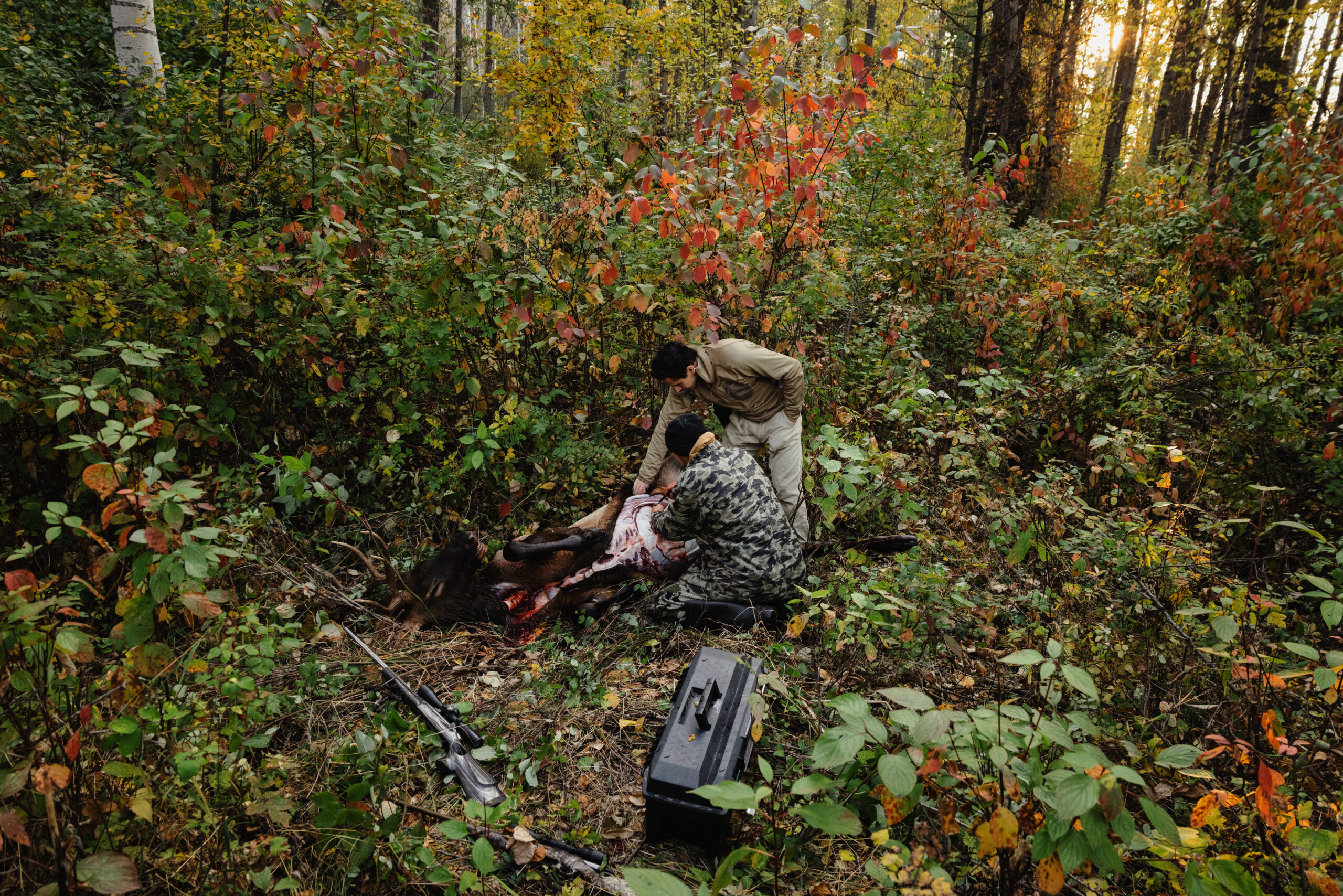
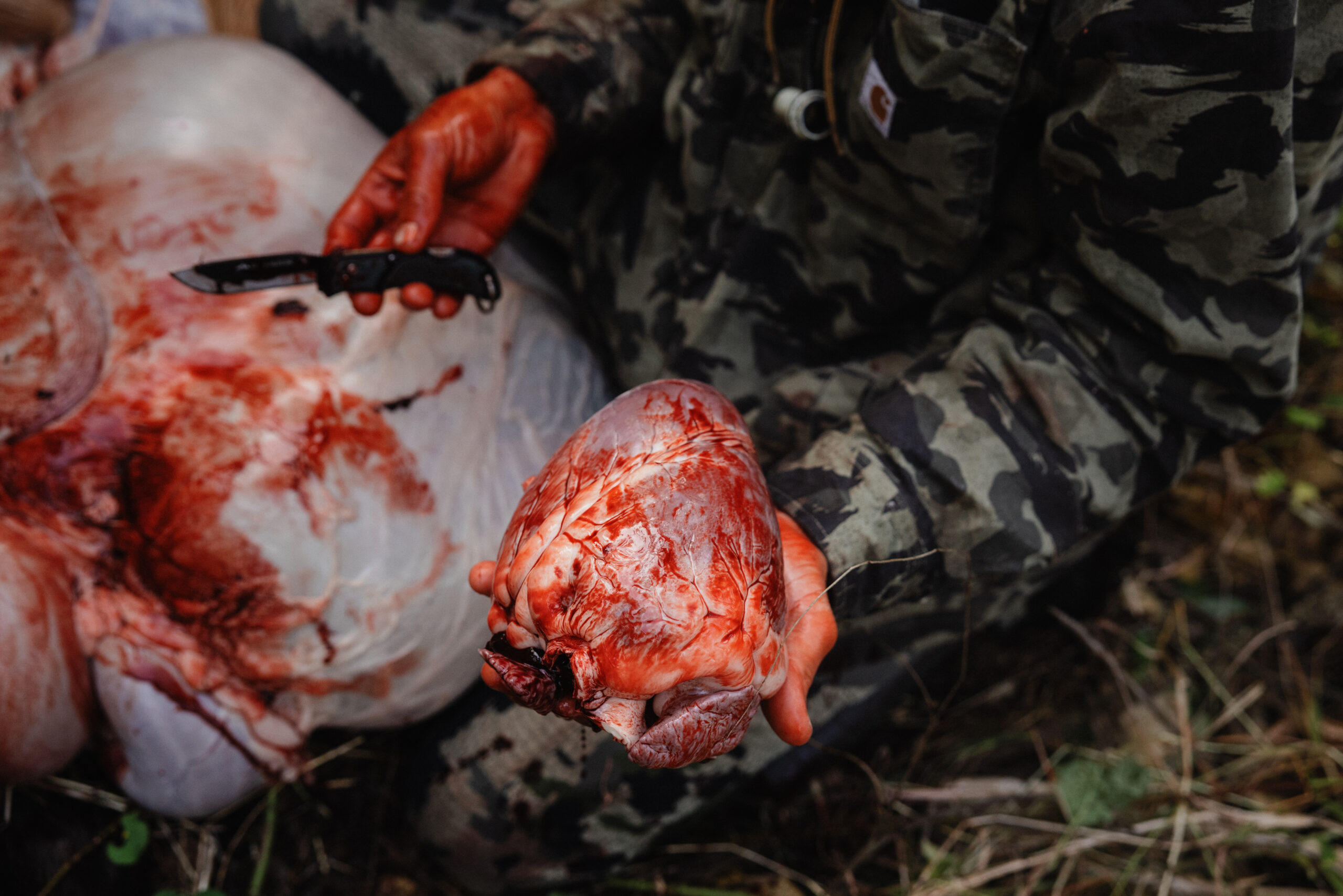
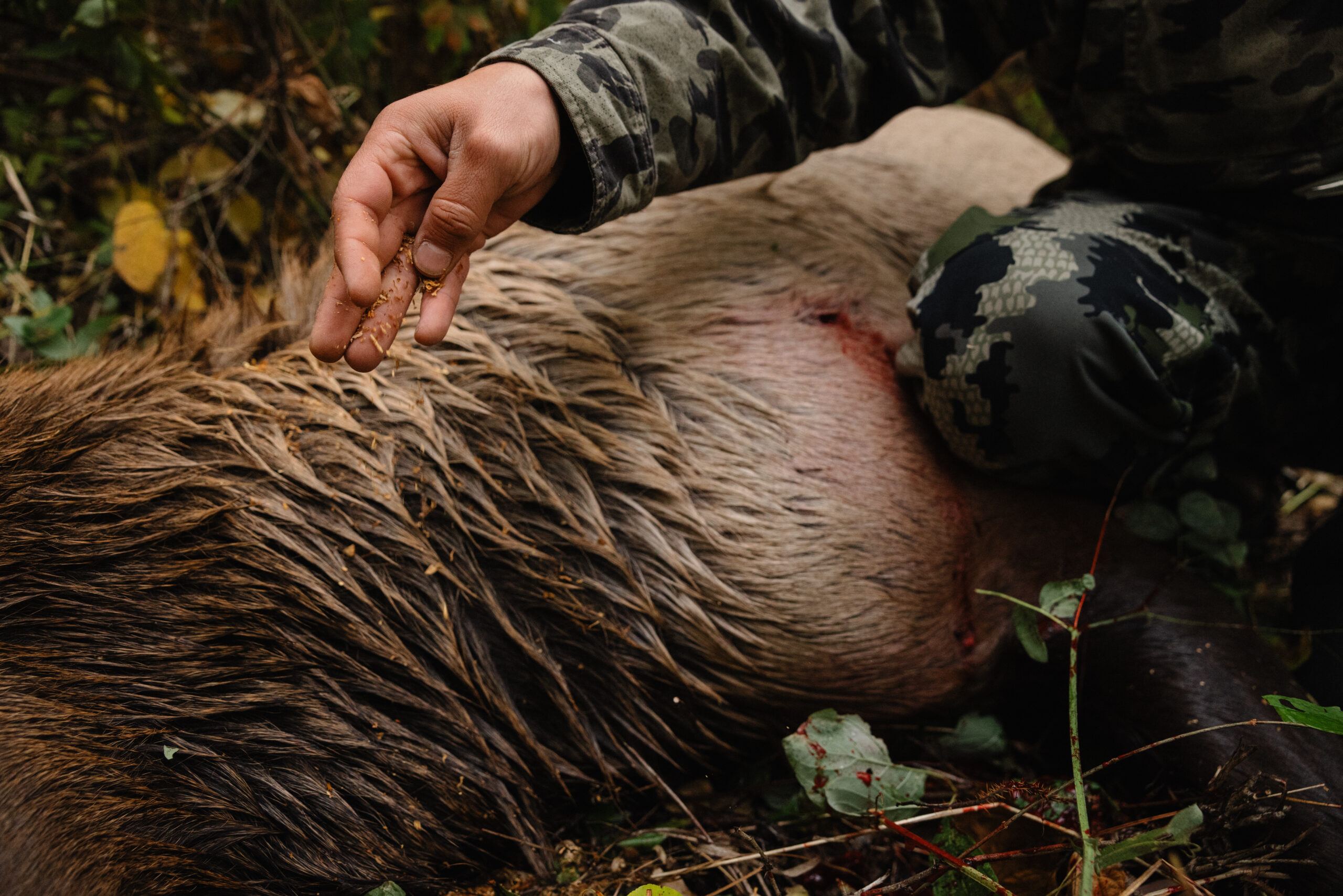
The meat in Bertacco’s freezer is low, so he’s happy to have harvested the elk, but the goal of the weekend is still to get a moose. A bull elk yields about two thirds as much meat as a bull moose.
Bertacco is on Lake Babine’s wildlife advisory committee, which includes members from each of Lake Babine’s five communities, as well as youth, Elders and urban representatives. The nation, which is negotiating the moose enhancement plan with the province, aims to connect community members like Bertacco directly with the province of B.C. to draw on their expertise and insights into what’s happening on the land. The specifics aren’t public, but Lake Babine has also signed a foundation agreement with the province and Canada. The agreement acknowledges the nation’s title and outlines a shared vision for their self-governance which includes a commitment to working towards joint management of moose in their territory.
The plan is still being finalized, but it includes monitoring carnivores like grizzlies as well as moose with drones and collars. The plan is anticipated to be finalized this summer and is likely to include wolf reduction as a key aspect.
Hessami is a member of the Wyandotte Nation of Oklahoma, and an avid hunter. He works with several First Nations, including Lake Babine, as an ecologist for Biodiversity Pathways, a subsidiary organization of the Alberta Biodiversity Monitoring Institute, which develops monitoring programs to inform land-use planning.
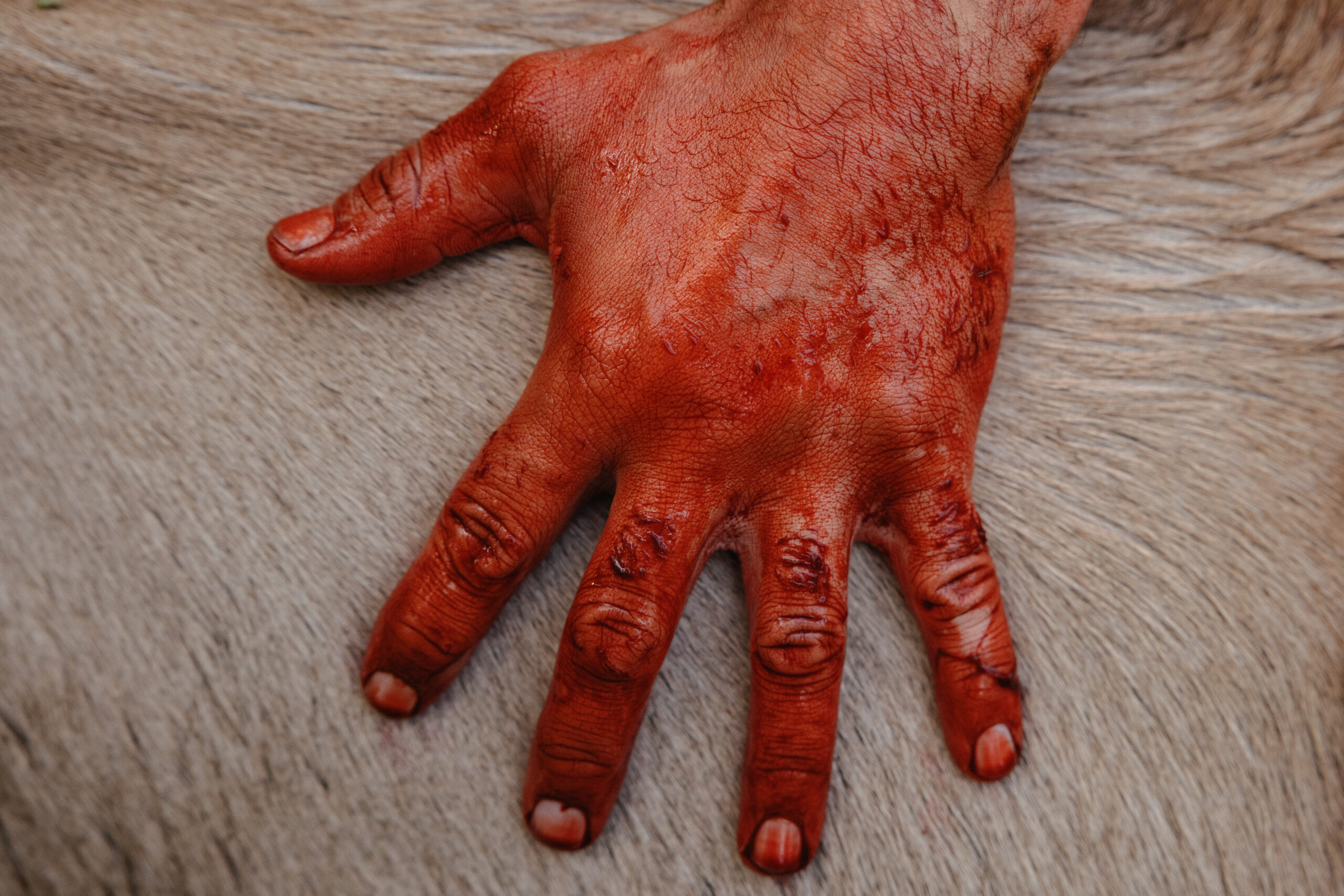
Species can be connected in very complex ways. Hessami explains moose benefit from patchy cutblocks that encourage the growth of food they rely on, while caribou benefit from undisturbed old-growth forest. Balancing the needs of different species while centring Indigenous sovereignty is central to Hessami’s scientific approach.
Moose weren’t always in Lake Babine lands, he says. They arrived in the territory partly due to humans altering the landscape.
“Two hundred years ago, this was mostly a caribou system. With logging and power lines and roads, moose, elk and deer moved in,” he says. This meant predators followed them, and they benefited from the cutblocks and roads.
Hessami points to the road ahead as Bertacco drives. “We walk on this road, we’d be about ten times more efficient than if we were walking in the bush,” he says. “Same for them.”
First Nations have always evolved with the land too. Historically, as resources shifted, so did the cultures and economies. But the stiff colonial structures around First Nations have created new obstacles in trying to move and adapt with the natural world — borders, permits, conflicting jurisdictions. These structures Canada is built on are often resistant to change, favouring stability versus fluidity.
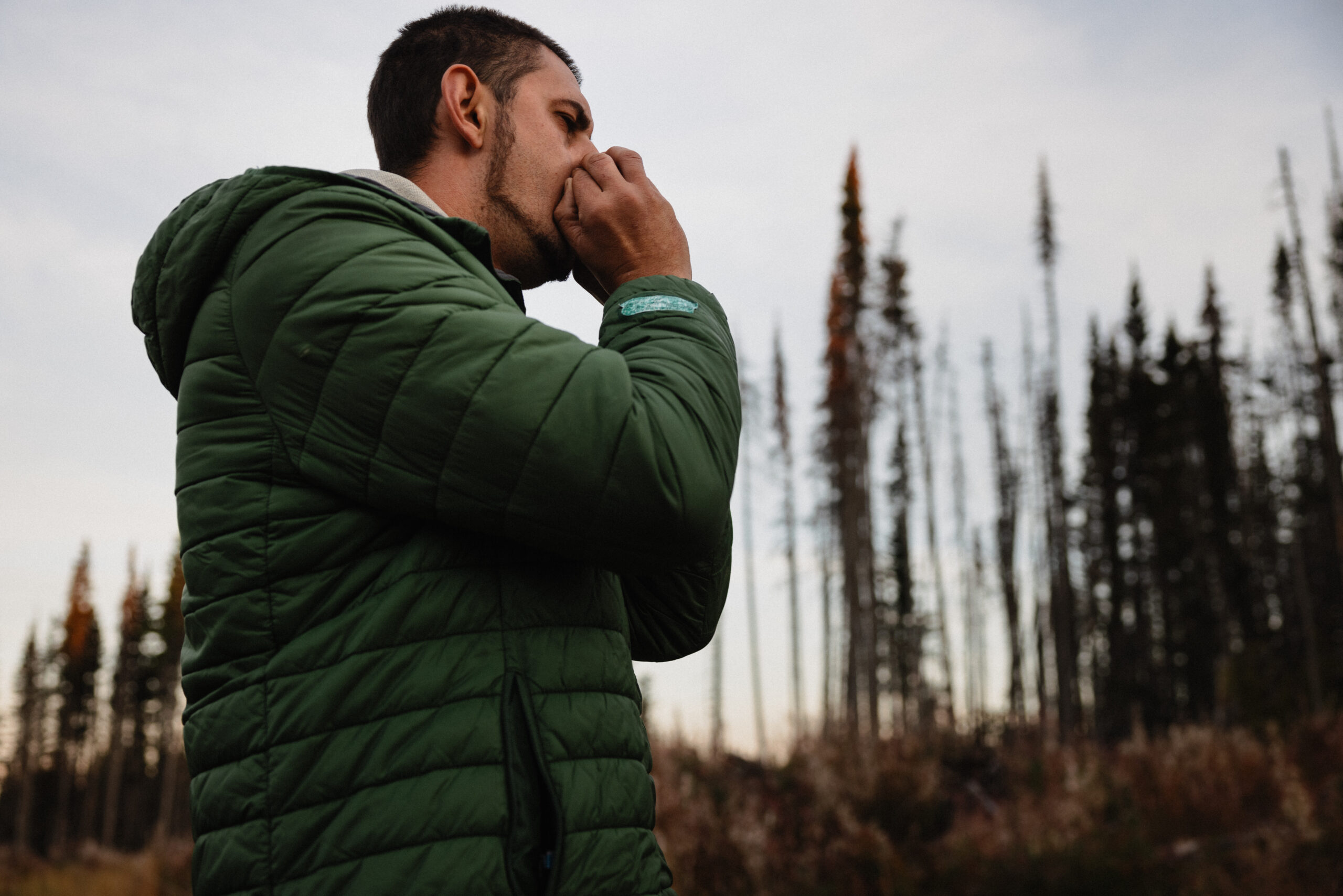
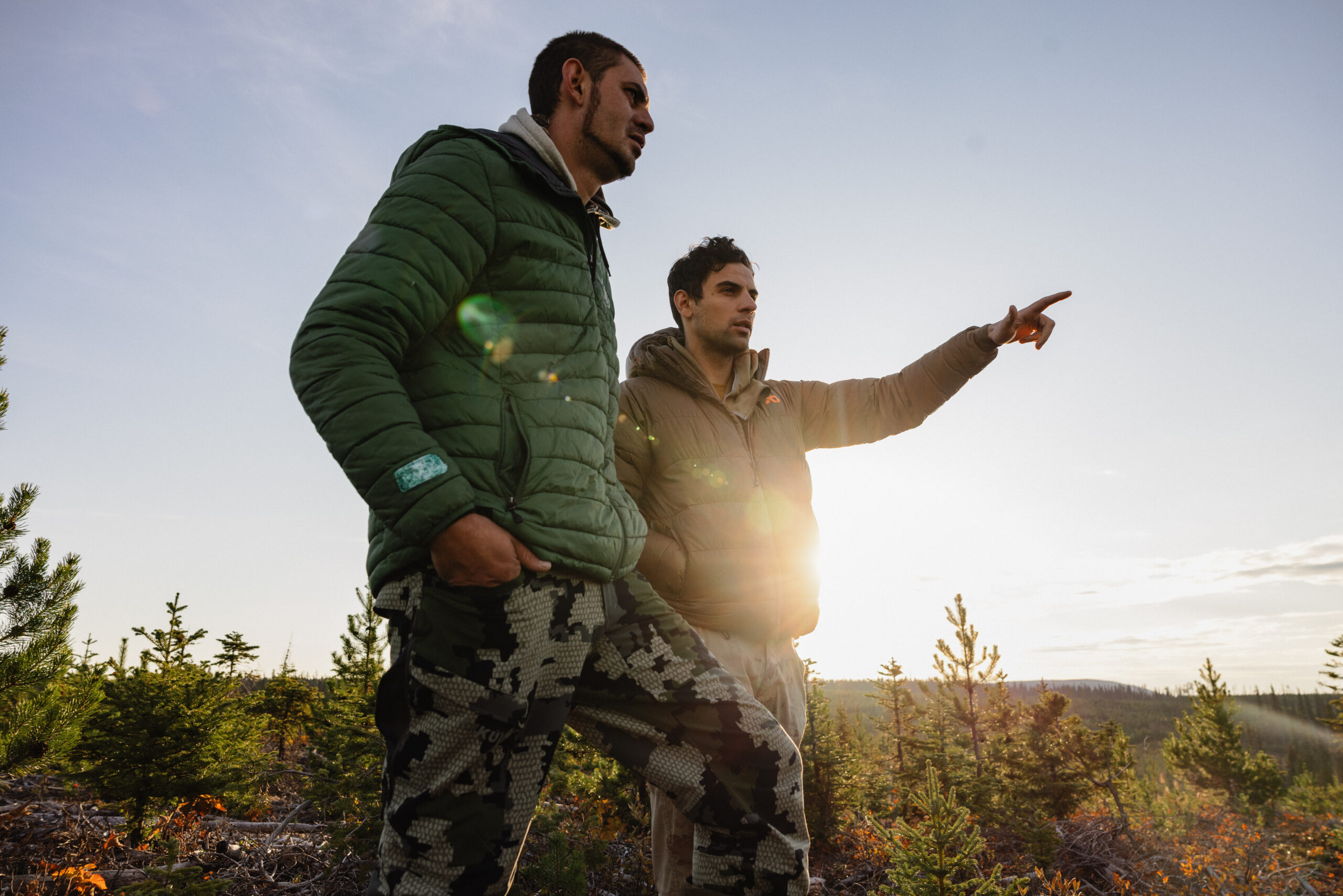
Lake Babine has built a deep cultural relationship with the moose, which are now a central part of its nation’s food security. But it also has to weigh provincial regulations in its decisions around managing moose and wolves. Industry has drastically altered the land, and First Nations face obstacles in responding to those changes.
The moose enhancement plan has been in the works since 2017, but is still not complete “because of the amount of regulations you have to go through,” Verna Power, matriarch and elected councillor, says over the phone. Power represents the Nedo’ats (Old Fort) community.
“It’s a slow-moving vehicle,” she says. “You have to work through the policies, the procedures, the regulations and laws. That’s the part that’s going to slow any project down when it comes to enhancing an animal population.”
But slow-moving doesn’t match the urgency Power feels. She worries about the loss of moose, and doesn’t want all the resources in their traditional territory to be exhausted with nothing left for future generations.
As Bertacco pulls up to his home in Burns Lake, his wife and six-year-old son come out to see the elk. Bertacco recruits a few people to help hang the elk in a shed before he brings it to the butcher, and then we go to warm up inside his house. He pulls out a wolf pelt as he shares stories of hunting predators each winter. His cat delightedly curls up on the pelt and begins to doze, as her kitten trots around sniffing it with curiosity.
“There’s a lot of wolves, especially in the wintertime,” Bertacco says. “That’s when I start hunting them.” Often when he’s doing his moose calls, he hears wolf calls in return. Predators and hunters are his two main concerns when it comes to moose. He will only harvest one moose a year, but a wolf pack hunts all year round. Coyotes and bears hunt during calving season between May and June, which he says impacts the recovery of the moose population.
“Predator hunting is a must in order to keep balance,” he says.
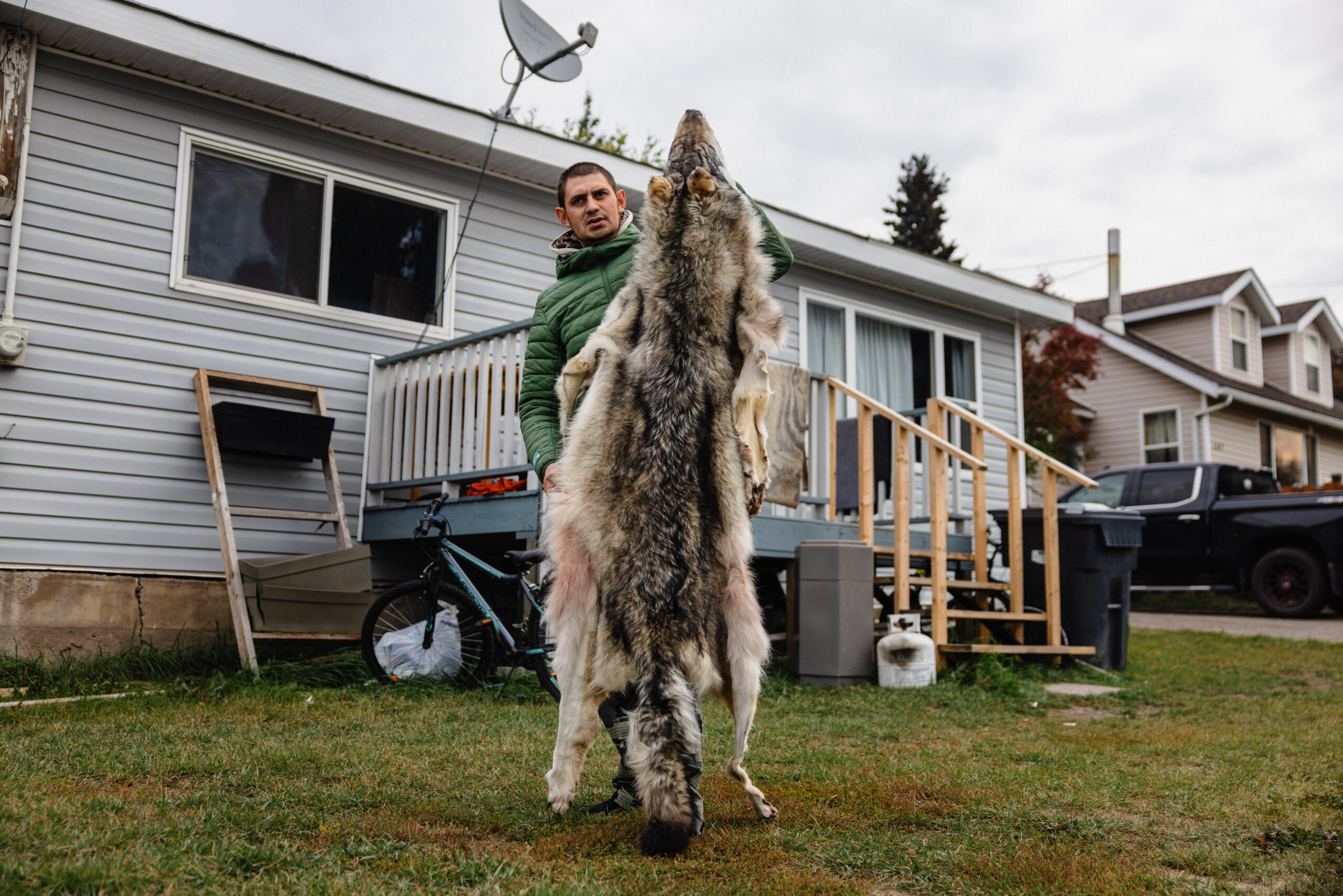
Predator management will be central to the moose enhancement plan, and everyone is aware of how the broader public can be opposed to that practice, Hessami says. Organizations like Raincoast Conservation Foundation and Pacific Wild have criticized the provincial wolf cull that was launched in 2015. According to CBC, $10 million has been spent on the cull and 1,944 wolves have been killed, and the province says this has helped stabilize or increase 13 out of 54 caribou herds, including the culturally important Klinse-Za herd in northeastern B.C.
Two scientists from Raincoast Conservation Foundation, Chris Darimont and Paul Paquet, recently wrote in a letter in the journal Science that some analyses of data casts questions on how effective the cull is. They argue the provincial government seems to be using the ongoing program as permission to allow industrial activities to continue degrading caribou habitats.”
Darimont and Paquet wrote that while B.C. pursues some restoration efforts, it simultaneously approves logging in critical caribou habitat. They argue the cull winds up serving as “an industrial subsidy” to allow extraction to continue while taxpayers shoulder the cost of mitigating its damage on caribou.
Hessami says the science behind monitoring the Klinse-za caribou herd is sound, but agreed action on logging has to be taken.
“Caribou need old-growth,” he says. “As the government continues to harvest old-growth, they are digging a hole for themselves.” He says the long-term solution would be restoring the logging roads that wolves are using like highways to hunt.
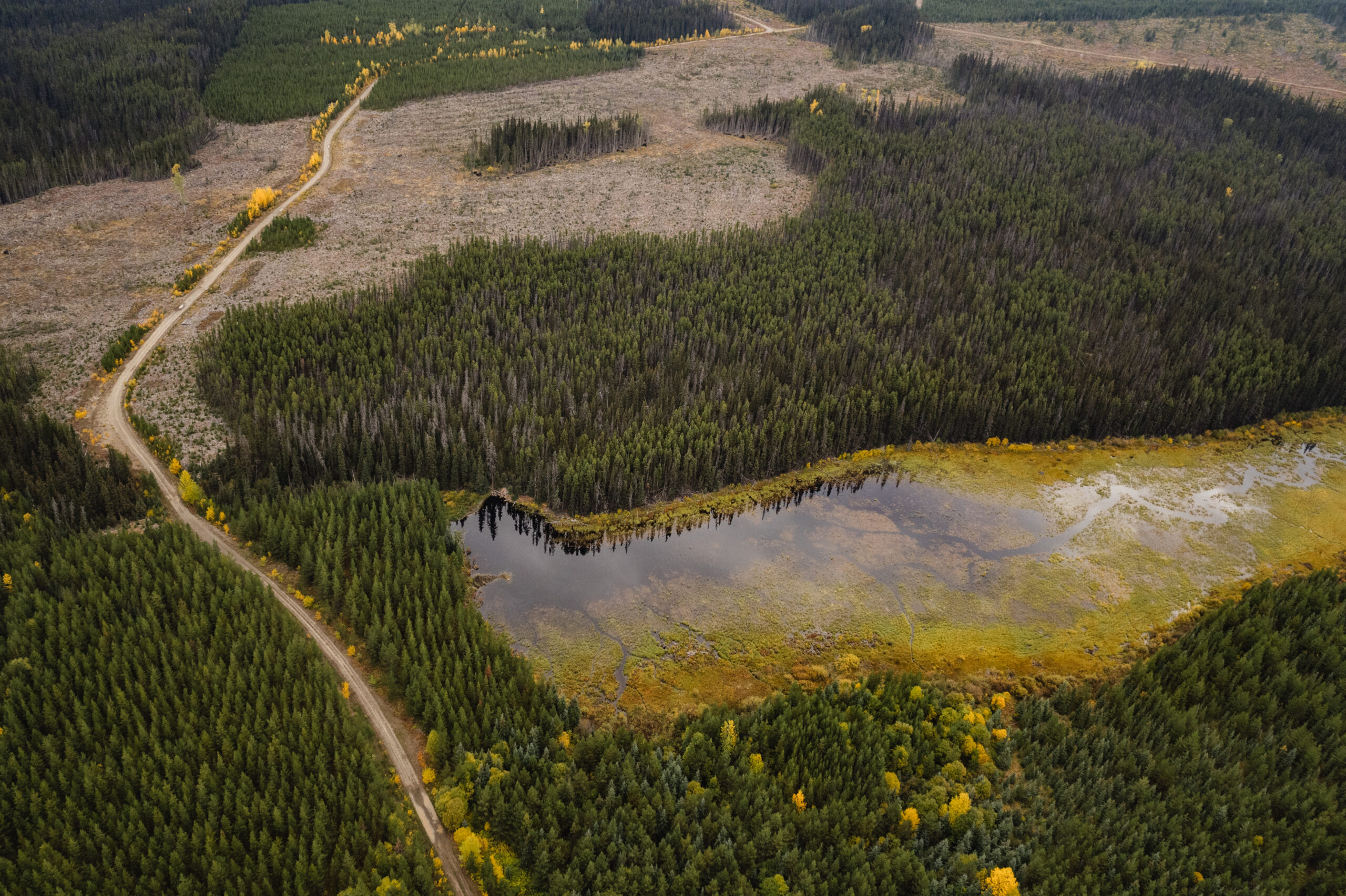
“But if we were to stop logging tomorrow, it would take probably 50 to 70 years for the forest to be grown up enough [to support caribou] to where we wouldn’t need to kill wolves,” he argues. He adds that with the extent of human impacts on the landscape and the threats of climate change, it’s still unclear if these new forests would be strong enough to support caribou.
Hessami employs two-eyed seeing — Indigenous Knowledge and western science. And he says both support predator management.
He points to the late wolf biologist Bob Hayes’ book Wolves of the Yukon, in which Hayes records an arrowhead found in a wolf den in Kaska Dena territory from 850 years ago, suggesting that Kaska hunters have a long history of managing predators. Traditionally, the furs of bears, wolves and other predators have cultural importance for coats, shoes, blankets and jewellery. Their meat would nourish the dogs or goes back to the forest for other animals, according to Power.
First Nations are part of the food web and always have been, Hessami says. “They were initiating predator management long before western societies came in.”

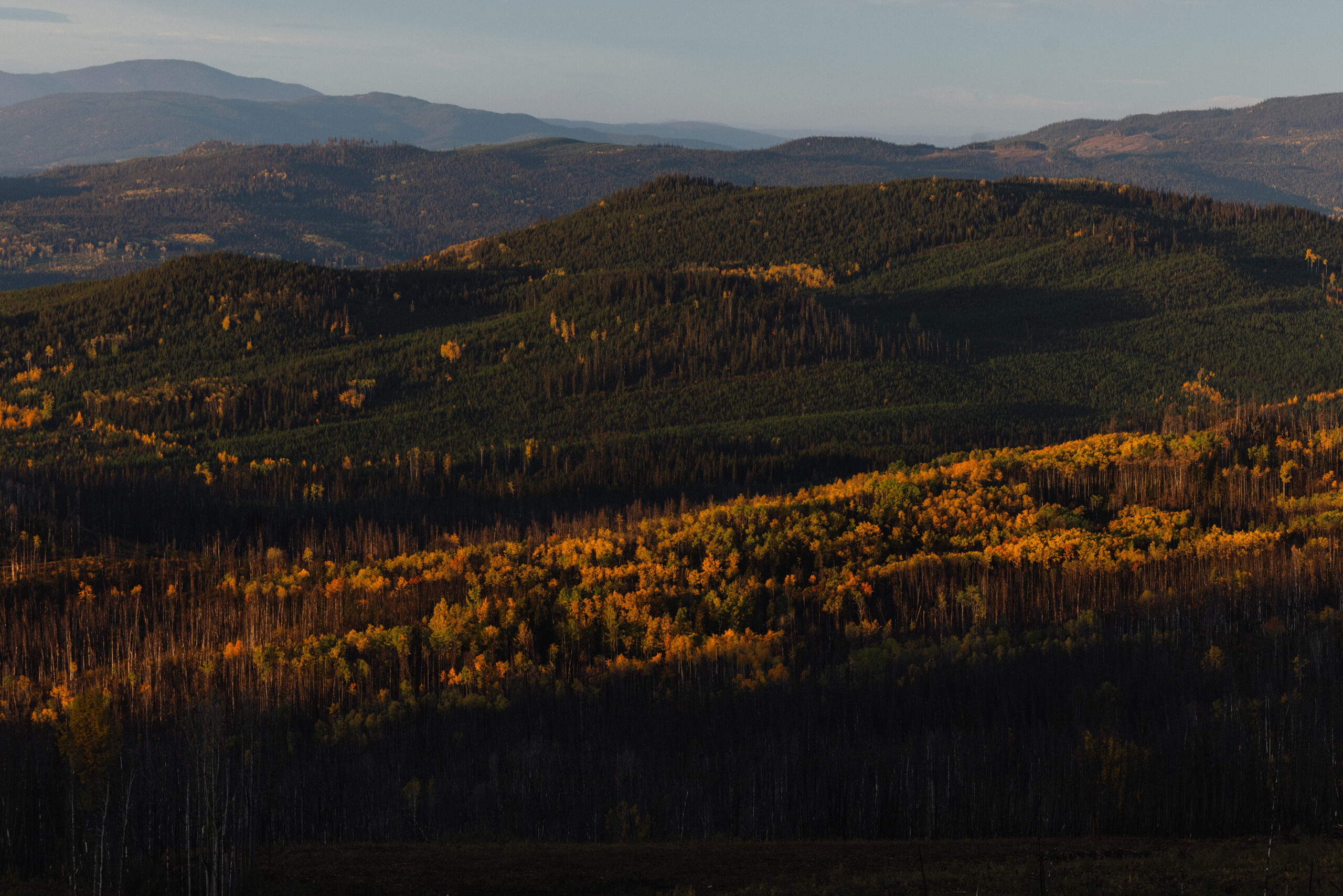
Power says cultural changes have contributed to the imbalance of wolves and bears on the territory. “We had trappers to control all of the predators, and now the trappers have literally disappeared,” she says. “You have a handful and that’s it. The handful aren’t getting out there to really control the predators.”
She wants to address the issue in a way that acknowledges the feelings of people who don’t support predator management.
“Yes, we need to protect the predators,” she says. “Right now, there’s overpopulation. How do we bring it back to a population that’s comfortable for not only society, but most importantly, that’s comfortable to ensure we can enhance moose?”
Power herself is a hunter. She began following her dad in the bush at seven years old, and felled her first moose at 13.
“As a matriarch, it’s important for me to ensure that grandchildren, whether they’re mine or someone else’s, are well cared for,” she says. That means teaching them to hunt and providing meat to people who can’t get out on the land.
“Moose sustains me,” she says. “The importance of it, for us to continue to sustain it for the future of our grandchildren — it is just as important as my blood flowing through my veins.”
After harvesting the elk, we join Bertacco as he brings some meat to a nearby Elder’s house. He says after he caught his last moose, the band asked him to share the meat with low-income families. They’re most impacted by the depletion of traditional foods, and restoring the moose population is important for the nation’s food security. Bertacco agreed to share his harvest, and the band offered him money, which he refused. “I did it out of the goodness of my heart. I didn’t want anything for it,” he says. “I don’t need nothing.”
The next morning, Bertacco and Hessami hit the road early again, but the second day brings no luck — nothing but some moose tracks in a clearcut. As the daylight begins to wane, we walk into a lush marshy area. Hessami lays on a soft bed of moss and closes his eyes as a soft drizzle comes down. Bertacco goes farther into the clearing and keeps making moose calls, as he has patiently been doing for much of the day. His voice echoes through the wet, dense air of the woods.
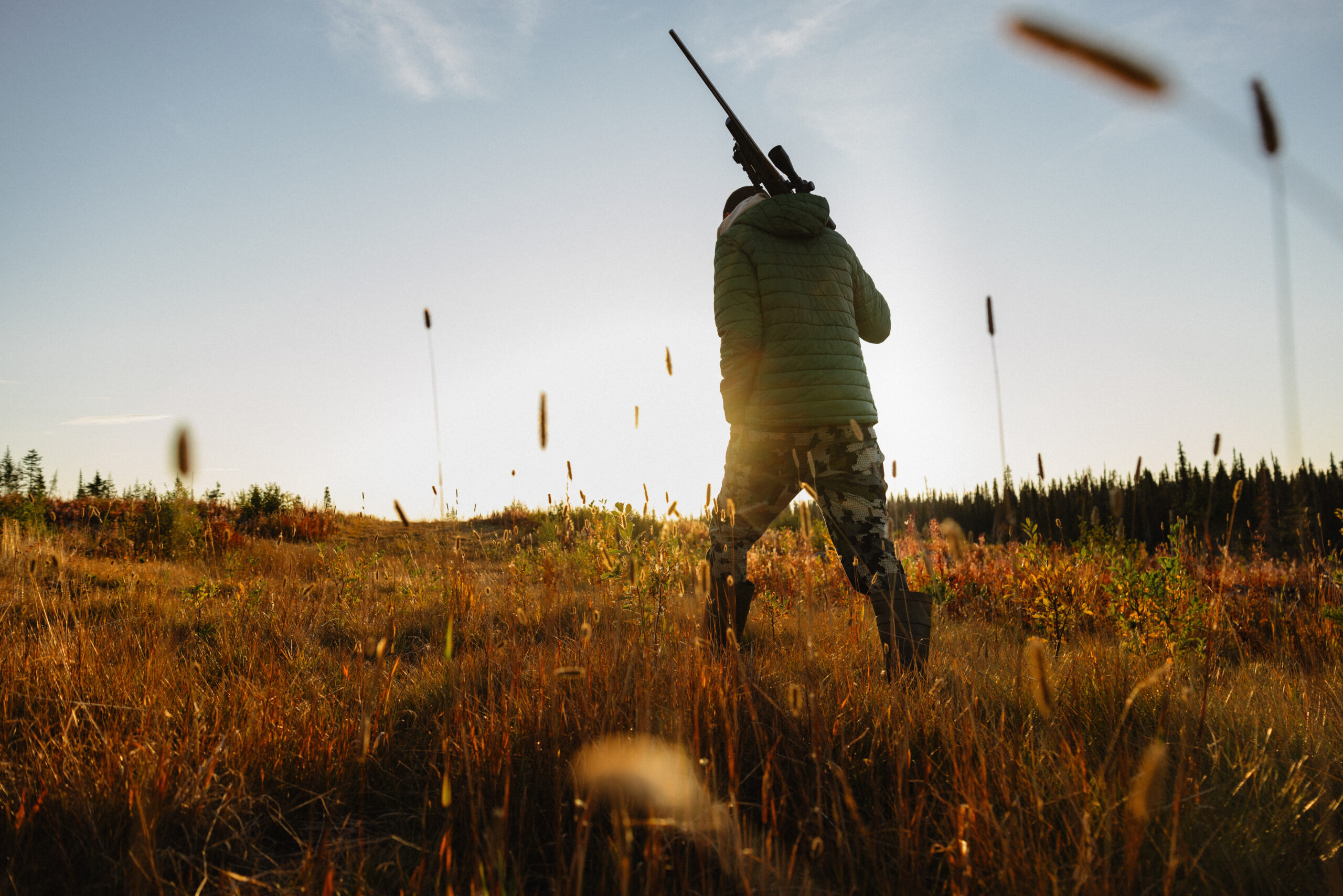
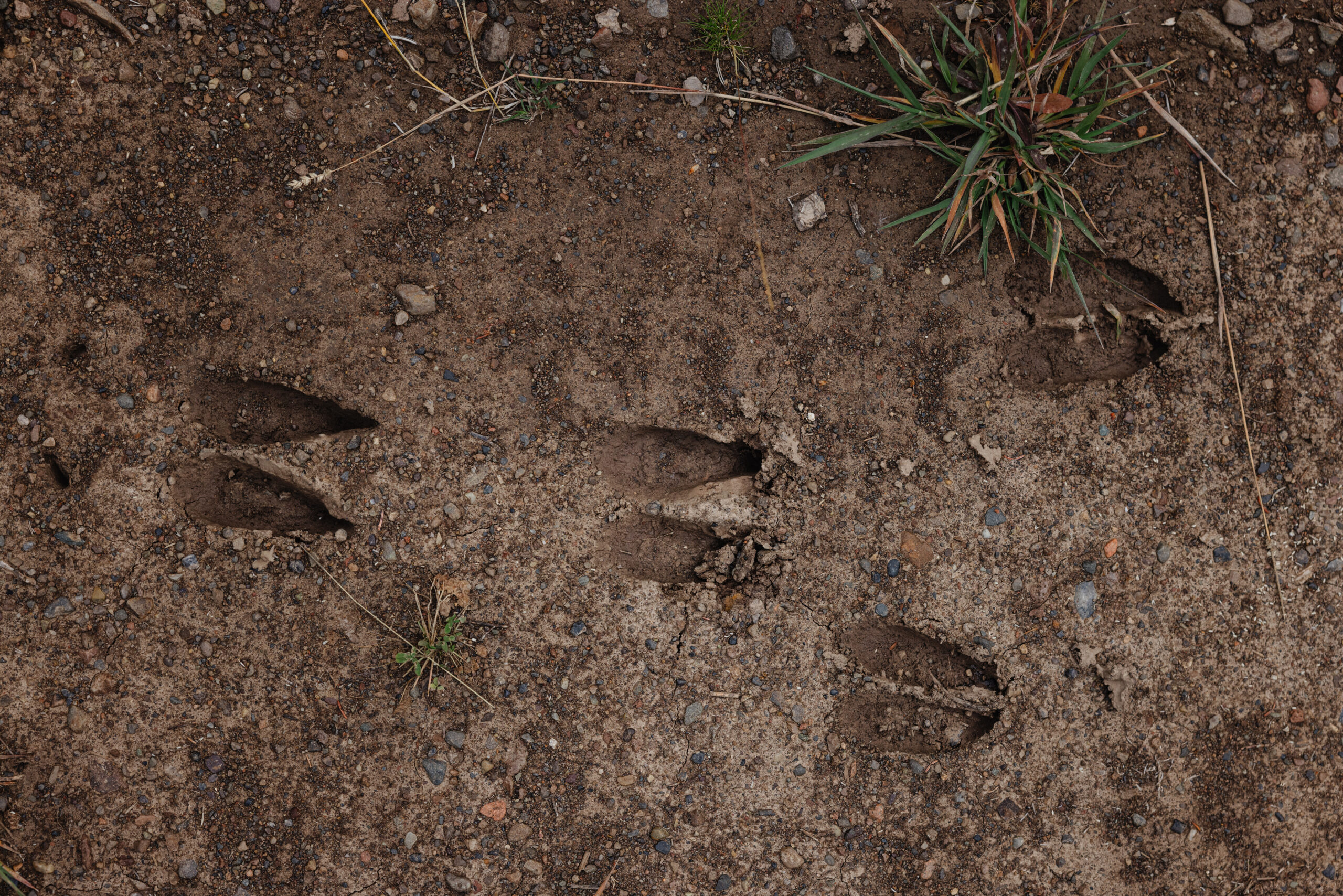
Bertacco calls it a night. They set plans to go out again in the morning.
In the car, they talk more about the pressures on moose. Bertacco says he noticed after forests near Prince George, B.C., were sprayed with glyphosate, moose “never came back.” Glyphosate is an herbicide used to get rid of what the logging industry sees as “pest” crops, like salal, huckleberry and red alder — plants that have provided food and medicine for Indigenous Peoples and non-humans for millennia. Glyphosate is used on deciduous trees that are not cash timber, but that moose rely on.
To manage habitat, the nation is reclaiming logging tenures in its territory. Power says in 2016 the nation had less than a one per cent stake in forestry activities in the territory, but today it controls more than 20 per cent. They are planning to do some sustainable logging, but also protect sensitive areas such as T’akh Tl’ah Bin (Morrison Lake), where a mine was proposed and eventually rejected.
“As we move forward, we’re creating more of these areas so that we’re not only protecting the salmon, the moose, the bear but the system, the whole system itself.”
Within different First Nations territories and jurisdictions, the Indigenous laws, community priorities and ecosystems are different. When B.C. said it would restrict the provincial moose hunt in order to to fall in line with the 2021 Blueberry River court case, four other Treaty 8 nations — Doig River, Halfway River, Prophet River and West Moberly — said those moose restrictions happened without their consent and asked for a solution that respected all of the nations’ Treaty Rights.
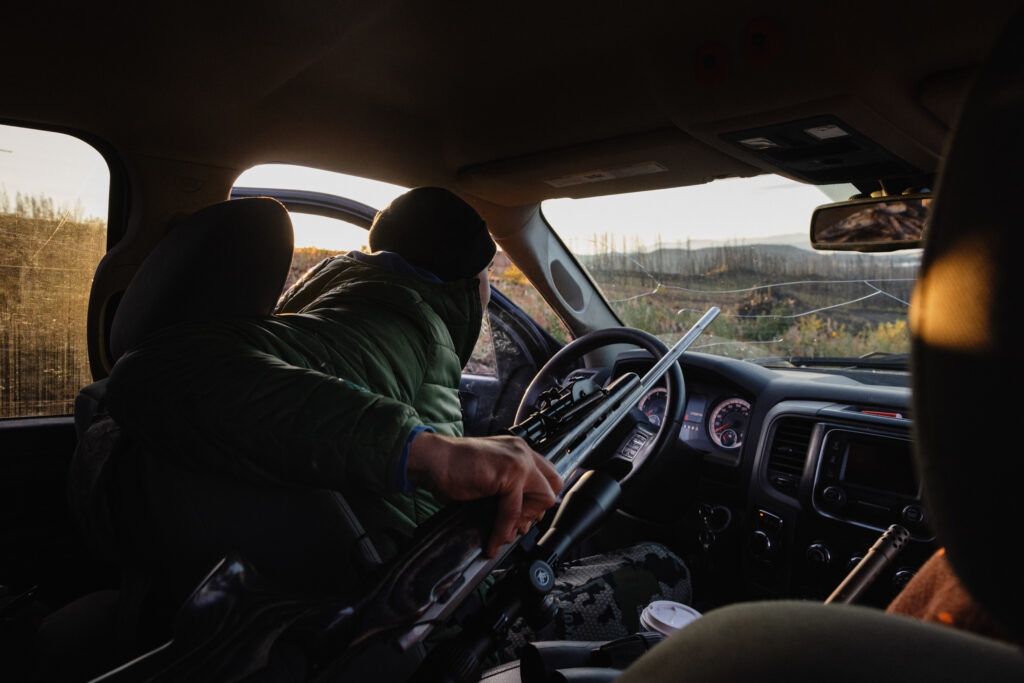
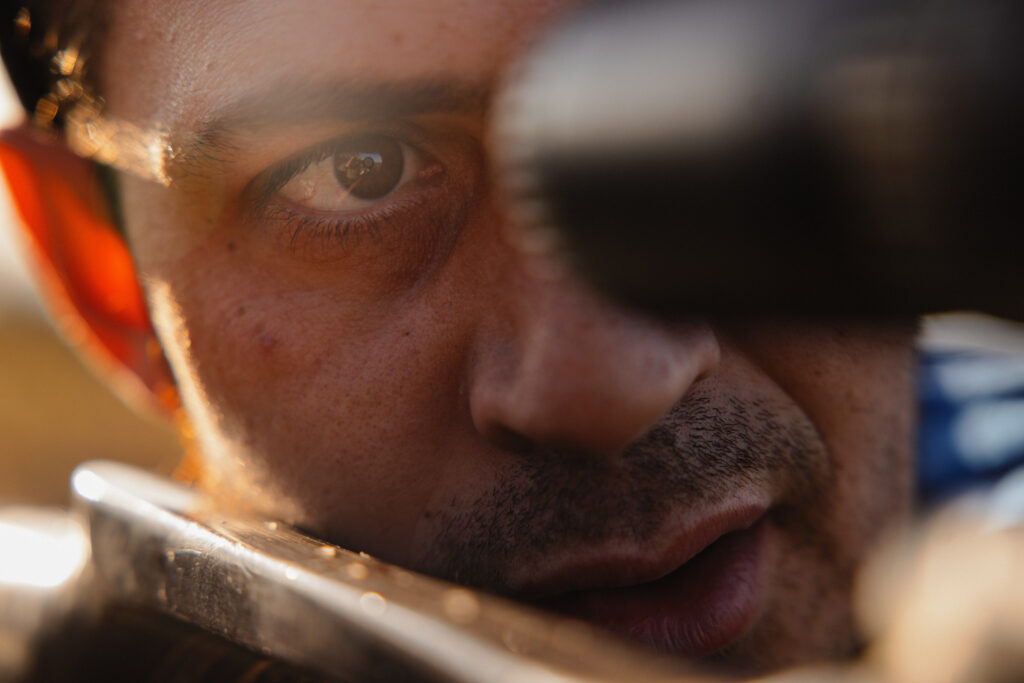
Indigenous knowledge systems are often focused on abundance and enhancing ecosystems to flourish, while provincial and federal law is often much more about the bare minimum — stabilizing at best, and at worst, monitoring a species to zero, Hessami says. He contributed to a recent paper analyzing how endangered species laws focus on a “minimum viable population” for a species’ survival, rather than much higher historical baselines or culturally meaningful abundance.
But radical improvements are possible, he argues, as long as there’s the political will. Keeping grocery shelves stocked in the city is a huge effort that no one would think to question, and he argues the public support has to be there for feeding rural Indigenous communities too. That means ensuring they can access local, traditional food sources like moose.
“Support communities to grow wildlife. It’s possible. If we can dam the Peace River, we can grow more moose. If we can get dams in the wildest places in B.C., we can grow more moose,” he says.
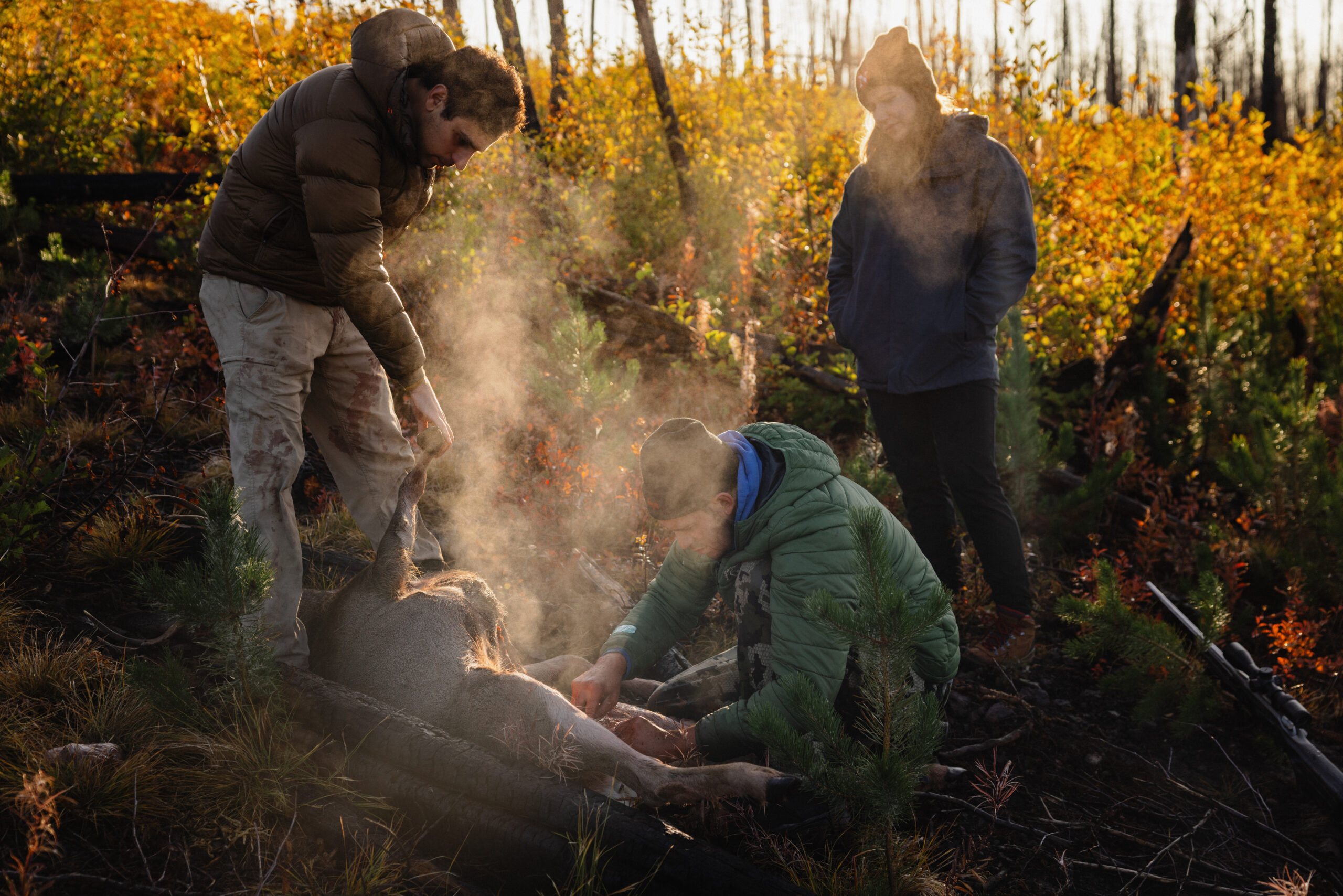
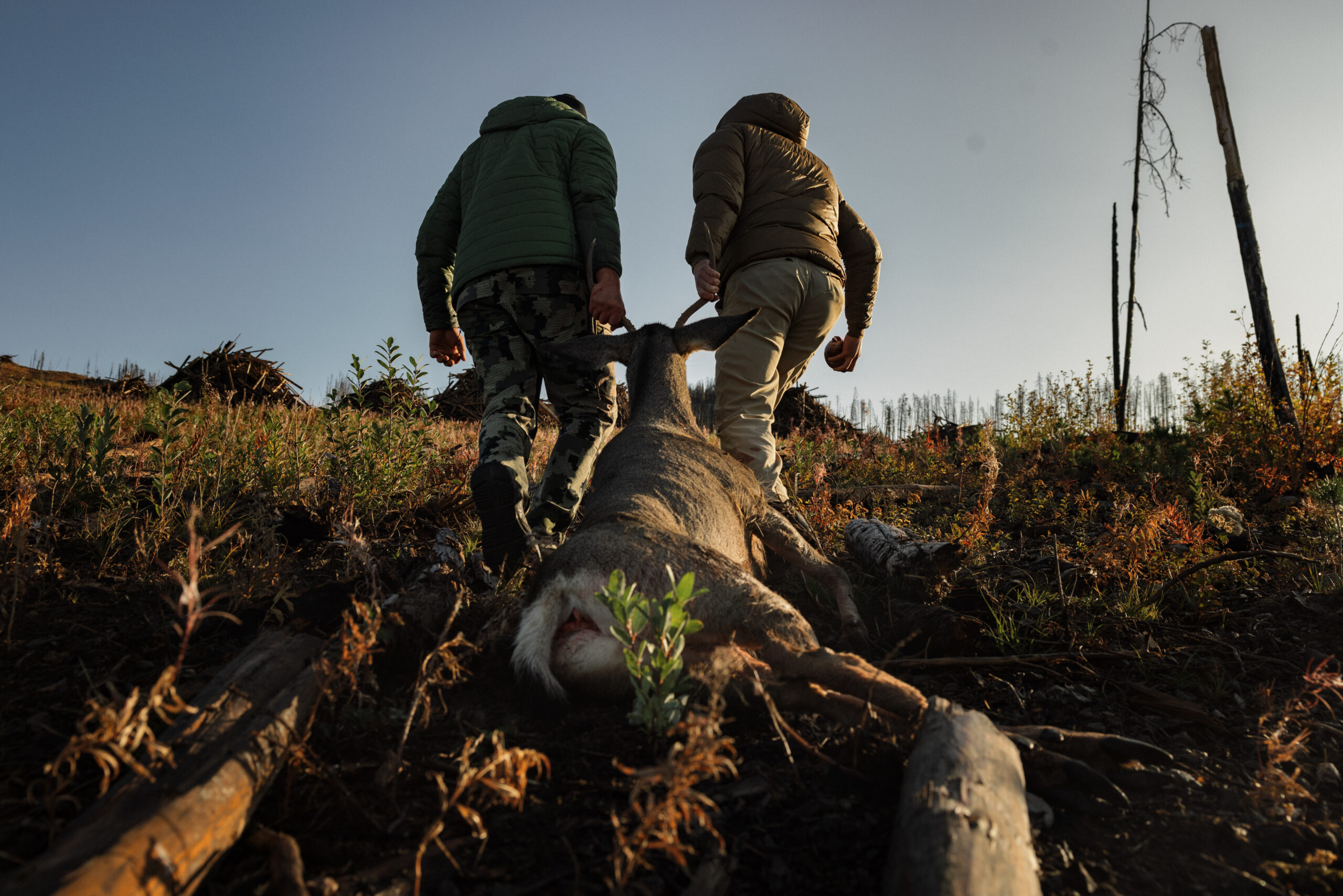
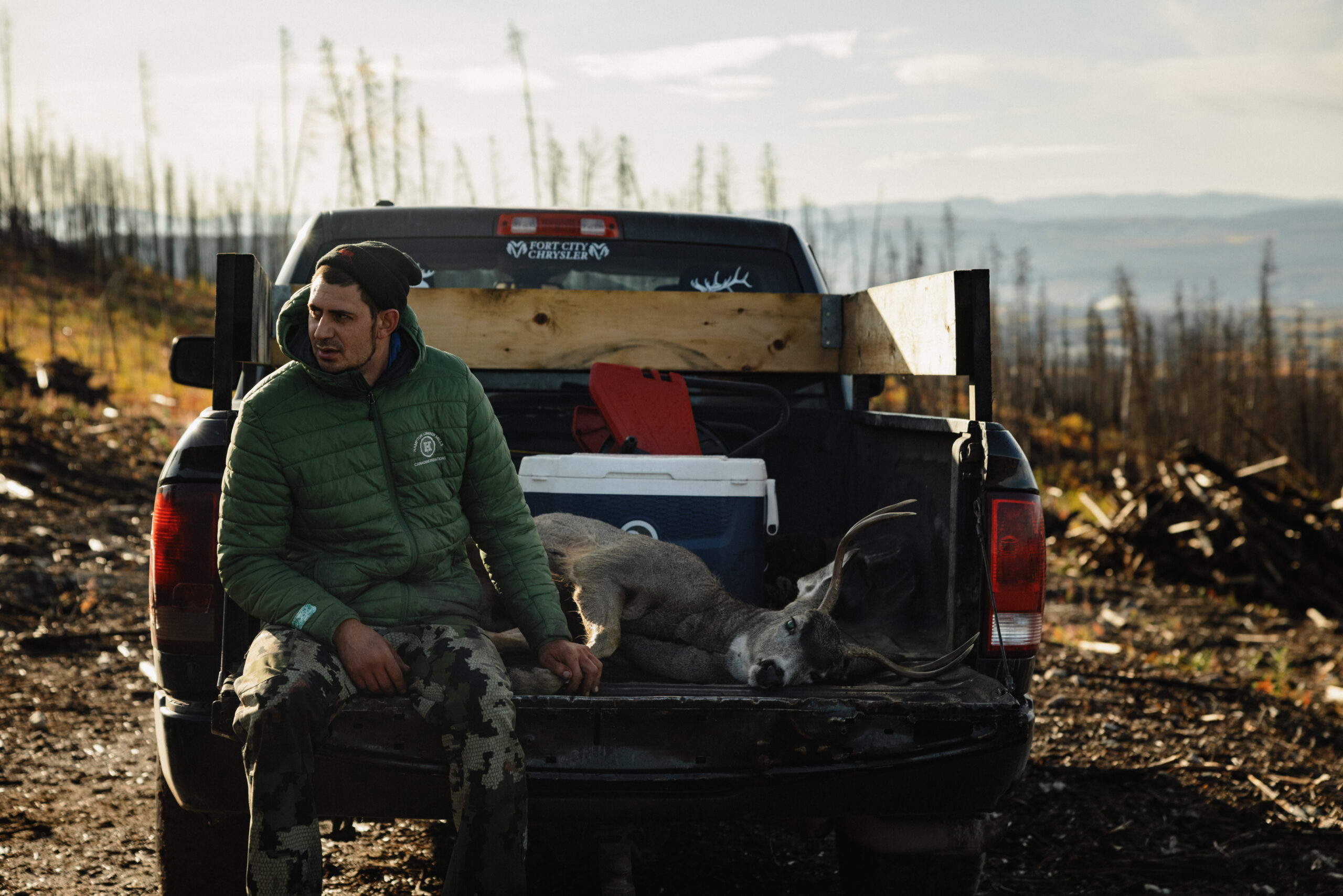
This year, Lake Babine is expanding its monitoring of moose and predators to establish baseline data — an important foundation for the co-management plan, and part of a larger journey in seeking support and recognition of their stewardship on the land.
The next morning around 4 a.m., Bertacco is optimistic on our way to one of his usual areas. “Early bird gets the worm,” he says as we drive there, while We Will Rock You by Queen plays on the car stereo. Once we arrive, he calls across cutblocks. He sees tracks, but no moose. No animals call back.
“I don’t think we’re rutting yet,” he says, but he’s still hopeful.
“It could pop out any time.”
Just before heading home around 9 a.m., he sees a young buck deer and successfully shoots. It’s a much easier harvest for a smaller and lighter animal. “We got everything but a moose,” he jokes. But he’s happy to have the elk and deer to bring to the butcher.
The next week, Bertacco texts a photo — he got his moose just in time.
Get the inside scoop on The Narwhal’s environment and climate reporting by signing up for our free newsletter. Angello Johnson’s shoulders burn, and his arms...
Continue reading
First Nations are leading efforts to make sure lake sturgeon can find a home in...

We’re excited to share that an investigation by The Narwhal is a finalist for the...

A new documentary, Nechako: It Will Be a Big River Again, dives into how two...
